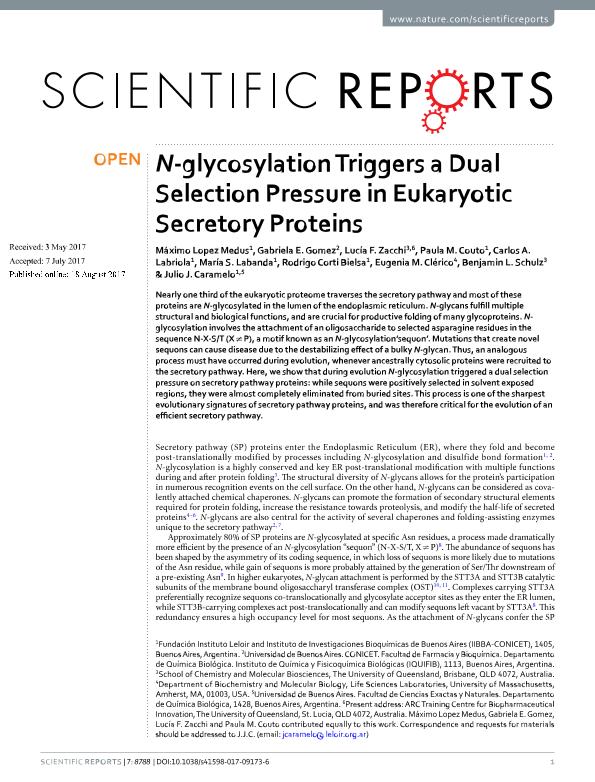Artículo
N-glycosylation Triggers a Dual Selection Pressure in Eukaryotic Secretory Proteins
López Medus, Máximo ; Gomez, Gabriela Elena
; Gomez, Gabriela Elena ; Zacchi, Lucia Florencia
; Zacchi, Lucia Florencia ; Couto, Paula Monserrat
; Couto, Paula Monserrat ; Labriola, Carlos Alberto
; Labriola, Carlos Alberto ; Labanda, María Soledad
; Labanda, María Soledad ; Corti Bielsa, Rodrigo; Clerico, Eugenia; Schulz, Benjamin L.; Caramelo, Julio Javier
; Corti Bielsa, Rodrigo; Clerico, Eugenia; Schulz, Benjamin L.; Caramelo, Julio Javier
 ; Gomez, Gabriela Elena
; Gomez, Gabriela Elena ; Zacchi, Lucia Florencia
; Zacchi, Lucia Florencia ; Couto, Paula Monserrat
; Couto, Paula Monserrat ; Labriola, Carlos Alberto
; Labriola, Carlos Alberto ; Labanda, María Soledad
; Labanda, María Soledad ; Corti Bielsa, Rodrigo; Clerico, Eugenia; Schulz, Benjamin L.; Caramelo, Julio Javier
; Corti Bielsa, Rodrigo; Clerico, Eugenia; Schulz, Benjamin L.; Caramelo, Julio Javier
Fecha de publicación:
08/2017
Editorial:
Springer Nature
Revista:
Scientific Reports
ISSN:
2045-2322
Idioma:
Inglés
Tipo de recurso:
Artículo publicado
Clasificación temática:
Resumen
Nearly one third of the eukaryotic proteome traverses the secretory pathway and most of these proteins are N-glycosylated in the lumen of the endoplasmic reticulum. N-glycans fulfill multiple structural and biological functions, and are crucial for productive folding of many glycoproteins. N-glycosylation involves the attachment of an oligosaccharide to selected asparagine residues in the sequence N-X-S/T (X ≠ P), a motif known as an N-glycosylation’sequon’. Mutations that create novel sequons can cause disease due to the destabilizing effect of a bulky N-glycan. Thus, an analogous process must have occurred during evolution, whenever ancestrally cytosolic proteins were recruited to the secretory pathway. Here, we show that during evolution N-glycosylation triggered a dual selection pressure on secretory pathway proteins: while sequons were positively selected in solvent exposed regions, they were almost completely eliminated from buried sites. This process is one of the sharpest evolutionary signatures of secretory pathway proteins, and was therefore critical for the evolution of an efficient secretory pathway.
Palabras clave:
N-Glycosylation
,
Secretory Pathway
,
Bioinformatics
Archivos asociados
Licencia
Identificadores
Colecciones
Articulos(IQUIFIB)
Articulos de INST.DE QUIMICA Y FISICO-QUIMICA BIOLOGICAS "PROF. ALEJANDRO C. PALADINI"
Articulos de INST.DE QUIMICA Y FISICO-QUIMICA BIOLOGICAS "PROF. ALEJANDRO C. PALADINI"
Citación
López Medus, Máximo; Gomez, Gabriela Elena; Zacchi, Lucia Florencia; Couto, Paula Monserrat; Labriola, Carlos Alberto; et al.; N-glycosylation Triggers a Dual Selection Pressure in Eukaryotic Secretory Proteins; Springer Nature; Scientific Reports; 7; 1; 8-2017; 1-11
Compartir
Altmétricas



